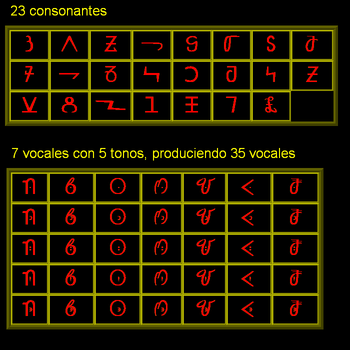Bassa alphabet
| Bassa vah | |
|---|---|
| Direction | Left-to-right |
| ISO 15924 |
Bass, 259 |
Unicode alias | Bassa Vah |
| Final Accepted Script Proposal | |

The Bassa script, known as Bassa vah or simply vah ('throwing a sign' in Bassa) is an alphabet for writing the Bassa language of Liberia. It was invented by Dr. Thomas Flo Lewis, who has instigated publishing of limited materials in the language from the mid-1900s through the 1930s, with its height in the 1910s and 1920s. It is alleged that some of the signs are based on native Bassa pictograms revealed by a former slave. It is not clear what connection it may have had with neighboring scripts, but type was cast for it, and an association for its promotion was formed in Liberia in 1959. It is not used contemporarily and has been classified as a failed script.[1] Its creation should be distinguished from other orthographic attempts in the 1830s by European missionaries.
Vah is a true alphabet, with 23 consonant letters, 7 vowel letters, and 5 tone diacritics, which are placed inside the vowels. It also has its own marks for commas and periods.
Unicode
The Bassa alphabet was added to the Unicode Standard in June 2014 with the release of version 7.0.
The Unicode block for the Bassa alphabet is U+16AD0–U+16AFF:
| Bassa Vah[1][2] Official Unicode Consortium code chart (PDF) | ||||||||||||||||
| 0 | 1 | 2 | 3 | 4 | 5 | 6 | 7 | 8 | 9 | A | B | C | D | E | F | |
| U+16ADx | 𖫐 | 𖫑 | 𖫒 | 𖫓 | 𖫔 | 𖫕 | 𖫖 | 𖫗 | 𖫘 | 𖫙 | 𖫚 | 𖫛 | 𖫜 | 𖫝 | 𖫞 | 𖫟 |
| U+16AEx | 𖫠 | 𖫡 | 𖫢 | 𖫣 | 𖫤 | 𖫥 | 𖫦 | 𖫧 | 𖫨 | 𖫩 | 𖫪 | 𖫫 | 𖫬 | 𖫭 | ||
| U+16AFx | 𖫰 | 𖫱 | 𖫲 | 𖫳 | 𖫴 | 𖫵 | ||||||||||
| Notes | ||||||||||||||||
References
- Coulmas (1999) The Blackwell Encyclopedia of Writing Systems
- ↑ Unseth, Peter. 2011. Invention of Scripts in West Africa for Ethnic Revitalization. In The Success-Failure Continuum in Language and Ethnic Identity Efforts, ed. by Joshua A. Fishman and Ofelia García, pp. 23-32. New York: Oxford University Press.